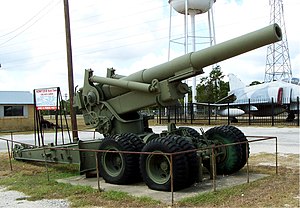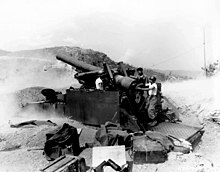M115 howitzer
| M115 203 mm howitzer | |
|---|---|
 M115 203 mm howitzer on display at Bastrop, Texas, United States. | |
| Type | Howitzer |
| Place of origin | United States |
| Service history | |
| Wars | World War II Korean War Vietnam War Iran–Iraq War |
| Production history | |
| Designed | 1939 |
| Produced | 1942–1945 |
| No. built | 1,006 [1] |
| Specifications | |
| Mass | 14,515 kg (31,780 lbs) |
| Length | Travel: 10.972 m (36 ft 0 in) |
| Barrel length | 5.1 m (16 ft 9 in)[2] L/25 |
| Width | Travel: 2.5 m (8 ft 2 in)[2] |
| Height | Travel: 2.7 m (8 ft 10 in)[2] |
| Crew | 14 |
| Shell | Separate loading charge and projectile 90.7 kg (200 lb)[2] |
| Caliber | 203 mm (8 in) |
| Breech | Interrupted screw |
| Recoil | Hydro-pneumatic |
| Carriage | Split trail |
| Elevation | −2° to +65° |
| Traverse | +60° |
| Rate of fire | 3 rounds per 2 minutes (maximum for first 3 minutes), 1 round per 2 minutes (sustained) [3] |
| Muzzle velocity | 587 m/s (1,926 ft/s) |
| Effective firing range | 16,800 m (18,373 yds) 22,860 m (25,000 yds) maximum |
The M115 203 mm howitzer, also known as the M115 8-inch howitzer, and originally the M1 8-inch howitzer was a towed heavy howitzer developed by the United States Army and used during World War II, the Korean War, and the Vietnam War. Post-WWII it was also adopted by a number of other nations in Europe, the Middle East, and Asia.
History
[edit]During World War I, licensed production of the British 8-inch howitzer Mark VI was undertaken by the Midvale Steel and Ordnance Company, located in the Nicetown neighborhood of Philadelphia, Pennsylvania. Both American and British-manufactured weapons were used by the American Expeditionary Force in France.[4] In 1940, the United States still had 475 Mark VII and Mark VIII 1/2 howitzers in storage, but there are no reports of the Mark VI or other marks being used during World War II.[5]
The original design of the M1 8-inch howitzer started in 1919, and resulted in the M1920 howitzer, but the program lapsed until resurrected in 1927. The T2 and T3 howitzers were prototypes of a partner piece for a new 155 mm gun.[6] The first publicity photographs of the M1-type 8-inch howitzer on its redesigned carriage appeared in 1931, but development was slowed by the Great Depression.[7] The T3 was standardized as the 8-inch howitzer M1 in 1940.
Like the British 8-inch howitzer of the First World War (and most other large artillery), the M1 uses a Welin screw for its breech. The carriage was the same as used for the US 155 mm gun and was also adopted by the British for their BL 7.2-inch howitzer. It consists of a split trail with equilibrator assemblies, elevating and traversing mechanisms, a two-axle bogie with eight tires, and a single-axle, single-wheel limber for towing. Four spades, carried on the trails, were used to emplace the weapon.
The M1 saw U.S. service in World War II, the Korean War, and the Vietnam War. During World War II, the M1 was towed by the Mack 7⅓ ton 6×6 truck or the M4 tractor. 59 battalions were raised during the war, of which 39 saw combat service in Northwest Europe or Italy and three in the Pacific.
In the late 1950s, it was adopted in small numbers by several NATO armies, to fire the W33 (M422/M422A1 shell) and later the W79 nuclear artillery shell, under the NATO nuclear sharing concept, a role which ended when the smallest types of tactical nuclear weapons were removed from service and eliminated. It was also adopted as a field weapon by a number of nations in Europe, the Middle East, and Asia and saw service in the Second Taiwan Strait Crisis and the Croatian War of Independence. In 1962, the M1 was redesignated the M115 howitzer.
Operators
[edit] Iran: 20 as of 2016[update][8]
Iran: 20 as of 2016[update][8] Iraq[citation needed]
Iraq[citation needed] Jordan: 4 in store as of 2016[update][9]
Jordan: 4 in store as of 2016[update][9] Netherlands[10]
Netherlands[10] Pakistan: 28 as of 2016[update][11]
Pakistan: 28 as of 2016[update][11] Saudi Arabia: 8 in store as of 2016[update][12]
Saudi Arabia: 8 in store as of 2016[update][12] South Korea: The Armed Forces acquired right after the Korean War in 1953. Began replacing in the late 2000s with the K9 Thunder.[13]
South Korea: The Armed Forces acquired right after the Korean War in 1953. Began replacing in the late 2000s with the K9 Thunder.[13] Sudan: in Turkey, 60 systems
Sudan: in Turkey, 60 systems Taiwan: 70 as of 2016[update][14]
Taiwan: 70 as of 2016[update][14] Turkey: 162 as of 2016[update][15]
Turkey: 162 as of 2016[update][15]
Former operators
[edit] Belgium: former operator, 14 systems in 1983[16]
Belgium: former operator, 14 systems in 1983[16] Croatia: former operator, 24 systems[citation needed]
Croatia: former operator, 24 systems[citation needed] Denmark: former operator[10] 1953–1996, 12 systems[citation needed]
Denmark: former operator[10] 1953–1996, 12 systems[citation needed] Greece: former operator[10]
Greece: former operator[10] Italy:[10]
Italy:[10] Japan: former operator[17]
Japan: former operator[17] Spain: former operator[10]
Spain: former operator[10] West Germany: former operator[citation needed]
West Germany: former operator[citation needed] United States: former operator[10]
United States: former operator[10]
Self-propelling mounts
[edit]
- The howitzer was mounted on a modified M4 medium tank chassis, in mount M17. The resulting vehicle was initially designated 8-inch howitzer motor carriage T89 and eventually standardized as the 8-inch howitzer motor carriage M43. A total of 48 units were built.[18]
- 8-inch howitzer motor carriage T80 – based on T23 Medium Tank chassis, never advanced past proposal stage.[19]
- 8-inch howitzer motor carriage T84 – based on T26 Medium Tank chassis, a single pilot was built in 1945.[20]
- The howitzer was mounted on a purpose-built tracked chassis to become the 8-inch self-propelled howitzer M110. Notably, accuracy and rate of fire suffered from having to depress the cannon tube to loading elevation for each round in order to use the track-mounted auto loader, but the later M110A1 & M110A2 version had improved accuracy and ranges.
Ammunition
[edit]The howitzer fired separate loading, bagged charge ammunition, with seven different propelling charges, from 1 (the smallest) to 7 (the largest).
| Type | Model | Weight | Filler | Muzzle velocity | Range |
|---|---|---|---|---|---|
| HE | HE M106 Shell (charge M2) | 90.7 kg (200 lb) | 594 m/s (1,950 ft/s) | 16,926 m (11 mi) | |
| HE | HE Mk 1A1 Shell (charge M1) | 90.7 kg (200 lb) | 408 m/s (1,340 ft/s) | 10,214 m (6.3 mi) | |
| Dummy | Dummy Mk 1 Projectile | — | — | — | |
| Nuclear | M442 (W33) nuclear shell | 243 lb (110 kg) | — | 547.1 m/s (1,795 ft/s)[23] | 18,000 m (11 mi) |
| Nuclear | XM753 (W79) nuclear shell | 200 lb (91 kg) | — | 601 m/s (1,970 ft/s)[24] | 24,000 m (15 mi), 30,000 m (19 mi) with rocket assist.[25] |
| Model | Weight, complete | Components |
|---|---|---|
| M1 ("green bag") | 6.3 kg (13 lb 14 oz) | Five incremental charges (for charges 1 to 5) |
| M2 ("white bag") | 13.56 kg (29 lb 14 oz) | Base charge and two incremental charges (for charges 5 to 7) |
| M4 (dummy) | 13.04 kg (28 lb 12 oz) | Base charge and two incremental charges |
| Ammunition / Distance | 2,743 m (3,000 yd) | 4,572 m (5,000 yd) | 9,144 m (10,000 yd) | 13,716 m (20,000 yd) |
|---|---|---|---|---|
| HE M106 Shell (meet angle 0°) | 1,432 mm (4 ft 8 in) | 1,219 mm (4 ft) | 975 mm (3 ft 2 in) | 945 mm (3 ft 1 in) |
Existing examples
Netherlands
[edit]- Wings of Liberation Museum Park in Best (near Eindhoven), Netherlands
See also
[edit]- 8-inch gun M1
- 203 mm howitzer M1931 (B-4) – approximate Soviet equivalent
- BL 7.2-inch howitzer – British equivalent
- List of U.S. Army weapons by supply catalog designation – SNL D-29
Notes
[edit]- ^ Official Munitions Production of the United States, by Months, 1 July 1940 – 31 August 1945 (War Production Board and Civilian Production Administration, 1 May 1947) p. 137
- ^ a b c d Foss, Christopher (1977). Jane's pocket book of towed artillery. New York: Collier. p. 141. ISBN 0-02-080600-0. OCLC 911907988.
- ^ "M110 8 inch (203 mm) Self-Propelled Howitzer". YouTube. Archived from the original on 9 June 2020. Retrieved 14 January 2022.
- ^ US Army manual TM 9-2005, December 1942 Archived 2010-07-14 at the Wayback Machine Page 79
- ^ Zaloga, Steven (2011). U.S. Field Artillery of World War II. New Vanguard 131. Osprey Publishing. pp. 22–23.
- ^ Zaloga, Steven (2011). U.S. Field Artillery of World War II. New Vanguard 131. Osprey Publishing. p. 23.
- ^ "First Mile A Minute Army", October 1931, Popular Science photo bottom of page 53
- ^ The Military Balance 2016, p. 328.
- ^ The Military Balance 2016, p. 336.
- ^ a b c d e f Wiener, Friedrich (1987). The armies of the NATO nations: Organization, concept of war, weapons and equipment. Truppendienst Handbooks Volume 3. Vienna: Herold Publishers. pp. 499–500.
- ^ The Military Balance 2016, p. 280.
- ^ The Military Balance 2016, p. 351.
- ^ Bak, Dongchan (March 2021). Korean War: Weapons of the United Nations (PDF) (in Korean). Republic of Korea: Ministry of Defense Institute for Military History. pp. 108–110. ISBN 979-11-5598-079-8.
- ^ The Military Balance 2016, p. 291.
- ^ The Military Balance 2016, p. 148.
- ^ Xavier Palson, La guerre de demain : Est/Ouest, Les forces en présence, Taillandier, April 1984, 258 p. ISBN 2235016006, p. 116.
- ^ Kenji Jyoshima; Yusuke Tsuge (October 2007). 陸自車両50年史 (50 Years of JGSDF's Vehicles) (in Japanese). Tokyo, Japan: Argonauts Publications. p. 123.
- ^ Hunnicutt - Sherman: A History of the American Medium Tank, pp. 353–355, 571.
- ^ Hunnicutt - Pershing, A History of the Medium Tank T20 Series, p. 158.
- ^ Hunnicutt - Pershing, A History of the Medium Tank T20 Series, p. 159.
- ^ Technical Manual TM 9-1901, Artillery Ammunition, pp. 203–205.
- ^ "W33". Global Security. Archived from the original on 25 July 2018. Retrieved 25 July 2018.
- ^ Henry E Hudgins (January 1977). Aerodynamics, Dimensions, Inertial Properties and Performance of Artillery Projectiles (PDF) (Report). Picatinny Arsenal. p. 145. Archived (PDF) from the original on 19 December 2021. Retrieved 24 December 2021.
- ^ Aerodynamics, Dimensions, Inertial Properties and Performance of Artillery Projectiles, p. 156.
- ^ Sandia Weapon Review: Nuclear Weapon Characteristics Handbook (PDF) (Report). Sandia National Labs. September 1990. p. 75. SAND90-1238. Archived (PDF) from the original on 12 January 2022.
- ^ Technical Manual TM 9-1901, Artillery Ammunition, p 301, 311.
- ^ Hunnicutt - Sherman: A History of the American Medium Tank, p 571.
References
[edit]- Hunnicutt, R. P. (1994). Sherman: A History of the American Medium Tank. Presidio Press. ISBN 0-89141-080-5.
- Hunnicutt, R. P. (1996). Pershing: A History of the Medium Tank T20 Series. Feist Publications. ISBN 1-112-95450-3.
- International Institute for Strategic Studies (February 2016). The Military Balance 2016. Vol. 116. Routlegde. ISBN 978-1-85743-835-2.
- Technical Manual TM 9-1901: Artillery Ammunition. War Department. 1944.
- "M115 8 in (203 mm) howitzer". FAS Military Analysis Network. Retrieved 31 May 2005.
- Missing Lynx
- TM 9-2300 Standard Artillery and fire Control Material (dated Feb. 1944)
- TM 9-335
- TM 9-1350
External links
[edit] Media related to M115 203 mm howitzer at Wikimedia Commons
Media related to M115 203 mm howitzer at Wikimedia Commons
